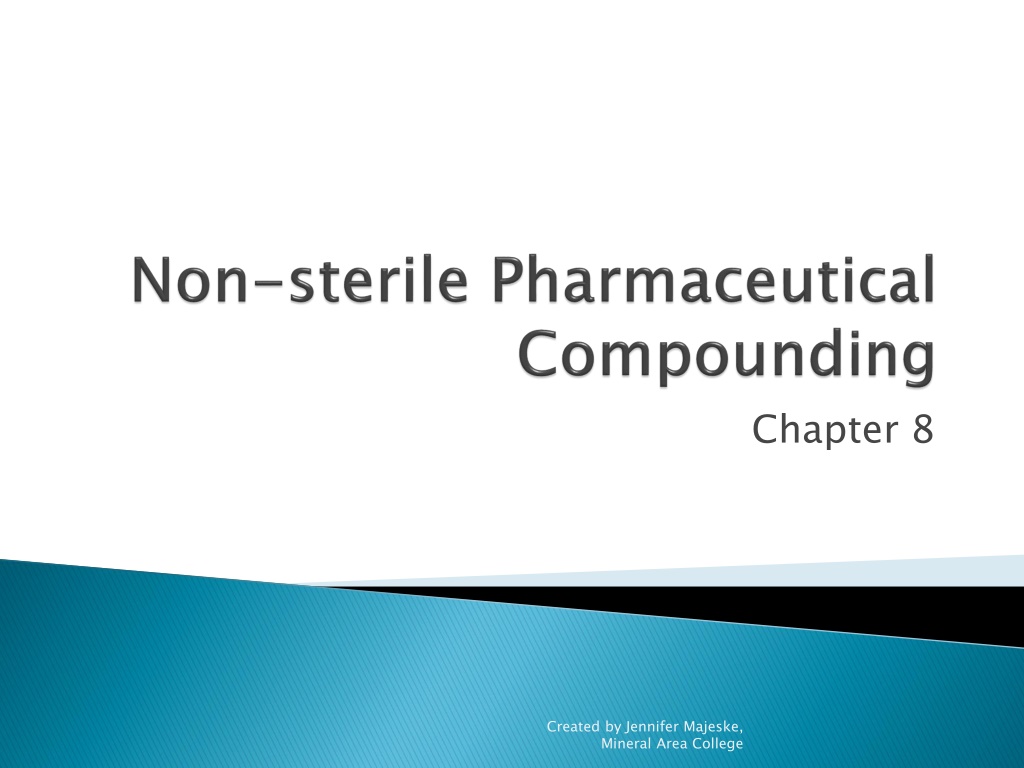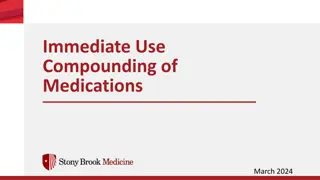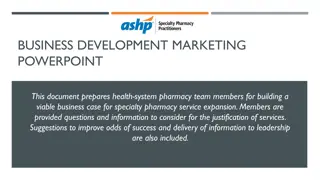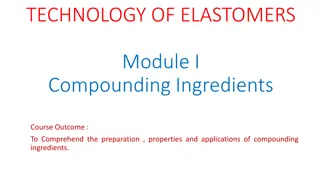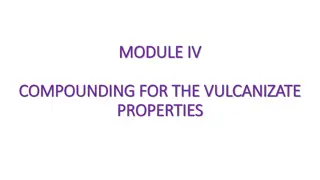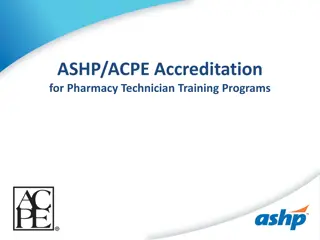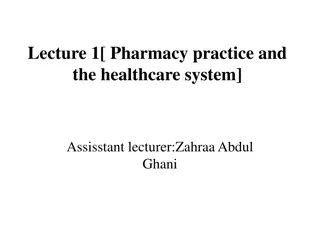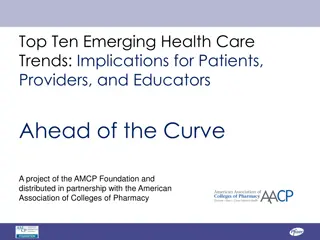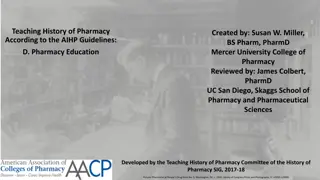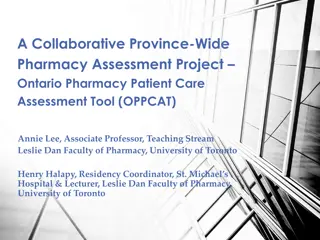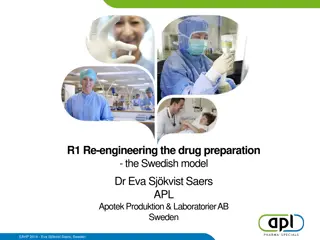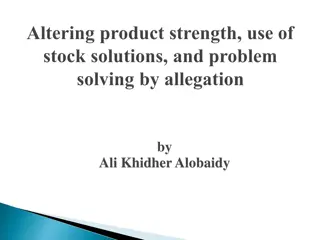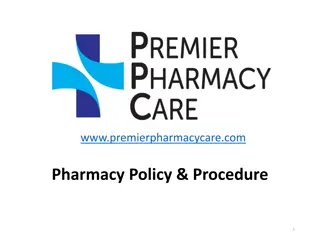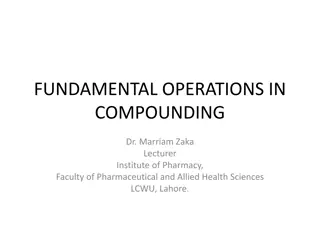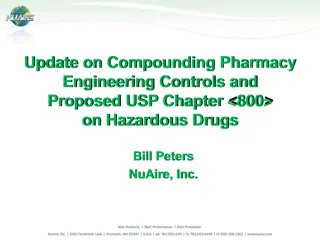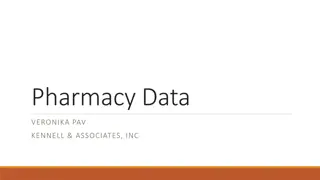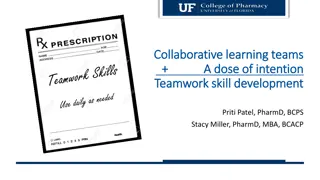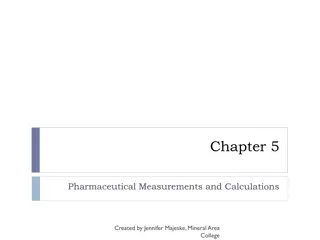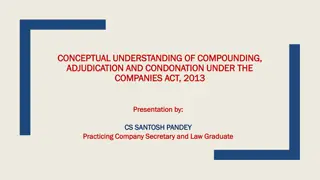Exploring Compounding Practices in Pharmacy Education
Delve into the world of compounding in pharmacy, covering topics such as compounding requirements, FDA regulations, quality standards, accreditation processes, technician training, equipment functions, compounding techniques, and more. Understand the historical significance of compounding and its relevance in modern pharmacy practices.
- Pharmacy Education
- Compounding Practices
- FDA Regulations
- Technician Training
- Pharmaceutical Compounding
Download Presentation

Please find below an Image/Link to download the presentation.
The content on the website is provided AS IS for your information and personal use only. It may not be sold, licensed, or shared on other websites without obtaining consent from the author. Download presentation by click this link. If you encounter any issues during the download, it is possible that the publisher has removed the file from their server.
E N D
Presentation Transcript
Chapter 8 Created by Jennifer Majeske, Mineral Area College
Define the term compounding, describe common situations in which compounding is required, and identify rationale and examples of non-sterile compounding. Discuss the impact of the Food and Drug Administration Modernization Act (FDAMA) of 1997 on the practice of a compounding pharmacy. Understand the distinction between a manufactured product and a compounded non-sterile preparation. Created by Jennifer Majeske, Mineral Area College
Define the regulatory role of the state board of pharmacy. Identify quality standards for nonsterile compounding contained in USP Chapter <795>, including product selection and beyond-use or expiration dating. Review and follow the components of good compounding practices in the pharmacy. Discuss reasons and process for accreditation of specialty compounded pharmacies. Created by Jennifer Majeske, Mineral Area College
Understand the minimum training and attire requirements for pharmacy technicians in a compounding pharmacy. Distinguish the components and purpose of a master control record from a compounding log. Define the term percentage of error and understand how the concept relates to accuracy in the compounding pharmacy. Created by Jennifer Majeske, Mineral Area College
Identify and describe the function of the equipment used for the weighing, measuring, and compounding of pharmaceuticals. Explain the proper techniques for weighing pharmaceutical ingredients, measuring liquid volumes, and compounding nonsterile preparations. Define the various terms used for comminution and blending of pharmaceutical ingredients. Created by Jennifer Majeske, Mineral Area College
Examine the techniques by which solutions, suspensions, ointments, creams, powders, suppositories, and capsules are prepared. Understand and calculate common mathematical problems that occur in a compounding pharmacy. Identify the steps that are necessary in the compounding process. Compare reimbursement procedures of a compounding pharmacy and a retail pharmacy. Identify references with a specialty focus on compounding. Created by Jennifer Majeske, Mineral Area College
Until the mid-nineteenth century, pharmacists routinely prepared (compounded) a majority of all prescriptions. With large-scale manufacturing the need for compounding has lessened, some trends however indicate the practice is increasing. Approximately 30-40 million prescriptions are compounded in the U.S. each year. Extemporaneous compounding compounding of nonsterile preparations or products that are not commercially available. Created by Jennifer Majeske, Mineral Area College
Compounding pharmacist uses bulk ingredients to prepare a prescribed medication that treats a specific patient s medical condition. Sterile compounding aseptic technique to prepare sterile solutions, or solutions that are free of microorganisms, for parenteral products or ophthalmic preparations. Most sterile compounding is performed in the clean room environment. Compounding the process in which a Sterile compounding the process of using Created by Jennifer Majeske, Mineral Area College
Sterile compounding must be performed under strict controlled environmental conditions to minimize the risk of contamination of the compounded sterile preparations (CSPs). CSPs are administered parenterally; prepared under strict federal and state regulations. Most CSPs do not contain a preservative; these products have a brief beyond-use date of 24 72 hours due to sterility rather than stability concerns. Created by Jennifer Majeske, Mineral Area College
Non preparation of commercially unavailable drug formulations from bulk ingredients in the community pharmacy. Individualized prescriptions for patients. Unique medication requirements for animals; catering to an animal s species and size. What are some of the possible scenarios for non-sterile compounding? What is the role of the technician in non- sterile compounding? Non- -sterile compounding sterile compounding used in the Created by Jennifer Majeske, Mineral Area College
For sterile and non-sterile compounding, federal and state laws and regulations along with United States Pharmacopeia (USP) standards and guidelines must be followed. Professional organizations: International Academy of Compounding Pharmacists (IACP), American Pharmacists Association (APhA), American Society of Health-System Pharmacists (ASHP), National Community Pharmacists Association (NCPA) Compounding pharmacies are allowed to advertise their services, but not the compounding of specific preparations. Created by Jennifer Majeske, Mineral Area College
Before 1997, there were no specific federal or state laws governing the practices of pharmacy compounding. Pharmacists are allowed to, under the Food and Drug Administration Modernization Act of 1997, compound non-sterile and/or sterile medications for a patient if these medications meet USP standards. Public health concerns are minor when mass production is not involved. Compounded products are typically used for a small group of patients with specific medical needs. Created by Jennifer Majeske, Mineral Area College
Compounding pharmacies must be licensed by both state and federal governments. Anticipatory compounding allowed to prepare an excess product, as long as quantities are reasonable. Pharmacies that compound and sell directly to other pharmacies or healthcare providers must apply for a manufacturing license. The need for additional regulations was obvious in 2012 with an outbreak of fungal meningitis from epidural injections of a contaminated corticosteroid. http://www.cdc.gov/hai/outbreaks/meningitis.html Anticipatory compounding pharmacies are Created by Jennifer Majeske, Mineral Area College
USP has developed standards to enhance patient safety and protect pharmacists from litigation. USP Chapter <795> outlines protocol for non- sterile compounding; USP Chapter <797> outlines regulations for sterile compounding. Manufactured products pharmaceutical manufacturers (Eli Lilly and Merck). Compounded preparations pharmacies. Good compounding practices (GCPs) all compounded products should be prepared using GCPs. Manufactured products produced by Compounded preparations produced by Good compounding practices (GCPs) Table 8.1; Created by Jennifer Majeske, Mineral Area College
Quality controls consists of the use of high- grade pharmaceutical ingredients along with training of personnel, the preparations stability and consistency, safeguarding against calculation errors and documentation. General Facility Requirements: Adequate storage and space Appropriately maintained equipment High cleanliness Free of dust Must have an eyewash station Physically separate from the dispensing pharmacy Created by Jennifer Majeske, Mineral Area College
Quality of ingredients; only USP or National Formulary (NF) pharmaceutical-grade. Sources for Bulk Ingredients: The source for ingredients depends on cost, quality, and purity of product. Pharmaceutical Compounding Centers of America (PCCA) is a primary source of products Pharmacists should have more than one source of quality ingredients. Table 8.2 Bulk Product Contacts Created by Jennifer Majeske, Mineral Area College
Storage of Bulk Ingredients: Ingredients are commonly ordered two to three times a week depending on volume and inventory. Material Safety Data Sheet (MSDS) or Safety Data Sheet (SDS) hazards and flammability of chemicals and procedures for treatment of accidental ingestion or exposure. Bulk ingredients are typically stored in tight, light resistant containers at room temp. The technician should check expiration dates, the source of the ingredients, and the NDC number. Material Safety Data Sheet (MSDS) or Safety Data Sheet (SDS) contains important information on Created by Jennifer Majeske, Mineral Area College
Controlled Substances Inventory: Procedures and recording keeping for Schedule II compounds are detailed and extensive. Controlled substance inventory must be in locked storage accessible only to the pharmacist. Beyond compounded preparations based on stability and temperature storage conditions. Stability the same properties and characteristics that is possessed at the time of preparation. Beyond- -Use Dating Use Dating the expiration date of Stability the extent to which a product retains Created by Jennifer Majeske, Mineral Area College
Beyond-use dating is initiated at the time of compounding. Compounds should be prepared as close to the time of patient dispensing as possible. USP Chapter <795> provides estimates for beyond-use dating. Refrigerated aqueous solution or suspension has a beyond-use dating of 14-30 days. Solids, like tablets and capsules and non-aqueous solutions have a beyond-use date of 6 months or less. All other formulations have a 30-day beyond-use date or duration of therapy, whichever date is earlier. Created by Jennifer Majeske, Mineral Area College
A beyond-use date for a prescription of two or more active or inactive ingredients with varying expiration dates is trickier. The beyond-use date is determined by taking 25% of the remaining expiration date or 6 months, whichever is earlier. If dates differ, the earliest date is used. Examples 1 & 2 provide practice calculating the beyond-use of non-sterile preparations. Conservative beyond-use dating guidelines in USP Chapter <795> are most often used. Created by Jennifer Majeske, Mineral Area College
Compounding pharmacies are seeking national accreditation to protect patents and business from legal challenges. Pharmacy Compounding Accreditation Board (PCAB) quality and safety standards for voluntary accreditation. Continuous quality improvement process of written procedures in the PCAB standards designed to identify problems and recommend solutions. Pharmacy Compounding Accreditation Board (PCAB) accreditation organization; provides Continuous quality improvement (CQI) (CQI) the Created by Jennifer Majeske, Mineral Area College
Technicians in order to work in compounding pharmacies must obtain special certification and training. Certification of Pharmacy Technicians: Special certification (PCCA) Training Non-sterile Compounding Attire: Clean protective clothing Hairnet Long lab coat Disposable gloves Eye goggles Masks Double gowning Hand washing liquid antimicrobial soap, minimum of 15 seconds Created by Jennifer Majeske, Mineral Area College
Documentation of all active and inactive ingredients, procedures for sequencing and mixing. Master Control Record The master control record lists: Drug s name, strength, and dosage form Ingredients and quantities Sequencing and mixing instructions Includes the recommended beyond-use date, storage and labeling requirements. Master Control Record the recipe. Created by Jennifer Majeske, Mineral Area College
Compounding log prescription. The compounding log is used to document calculations and any special equipment. Prescription record copy of the log, stored and retrievable for future refills. What is listed on the compounding log? Figure 8.2 pg. 322 in your book is an example of a compounding log. Compounding log generated for each Prescription record computer-generated Created by Jennifer Majeske, Mineral Area College
Technicians must have a thorough knowledge of mathematical conversions and a good aptitude for performing calculations in a compounding pharmacy. A double check by both the pharmacist and technician is strongly recommended to minimize medication errors. All measurements and calculations must be documented and reviewed by the pharmacist during the final check of a compounded preparation. Created by Jennifer Majeske, Mineral Area College
A variety of equipment is utilized in a compounding pharmacy. Technicians need to be familiar with the equipment, its uses, and maintenance. All materials needed for proper packaging and labeling must be ensured by the pharmacy technician. Caution needs to be used for equipment in both sterile and non-sterile compounding pharmacies. Created by Jennifer Majeske, Mineral Area College
Accurately weighing ingredients is one of the most essential parts of compounding. Technicians must be comfortable using various balances when weighing products. Familiarity with the device s calibration is important when operating any type of balance. Two-Pan Balances: Class III prescription balance balance Counterbalance Class III prescription balance, Class A prescription Counterbalance Created by Jennifer Majeske, Mineral Area College
Weights are used for both measurement and calibration. Pharmaceutical weights used to offset the ingredient weight. Weights are generally made of polished brass, and can be coated with a non-corrosive material. Sets contain metric and apothecary weights. Typical sets are in grams, fractional grams (mg) and avoirdupois weights. Weights are placed on the right pan; material to be weight on the left pan. Pharmaceutical weights a standardized set, Created by Jennifer Majeske, Mineral Area College
Forceps and holding small objects; weights should be transferred using forceps not fingers. A cloth should be used when handling larger weights. Weighing paper protect the balances from damage and to avoid contact between pharmaceutical ingredients and the metal trays. Weighing boat quantities of chemicals. Forceps an instrument used for grasping Weighing paper is placed on the pans to Weighing boat used to weigh larger Created by Jennifer Majeske, Mineral Area College
Digital electronic analytical balance single pan and is easier to learn to use and more accurate than a Class III balance or counterbalance. Operating an Electronic Balance: Placed on a secure, level, and non-vibrating service at waist height; perfectly level. Calibration must be documented. Avoid spilling. Table 8.3 pg. 326 Steps for Using an Electronic Balance Digital electronic analytical balance uses a Created by Jennifer Majeske, Mineral Area College
Percentage of error variation above and below the target measurement of a bulk ingredient. Determining percentage of error: The amount of error is the difference between the actual amount and the quantity desired: ?????? ?????? ???????? ??????? = ?????? ?? ????? Percentage of error the acceptable range of ?????? ?? ????? ???????? ??????? x 100 = percentage of error Created by Jennifer Majeske, Mineral Area College
Volumetric measurement liquid volumes. Graduated cylinders polypropylene flask used for measuring liquids. Conical graduates have wide tops and narrow bases and taper from top to bottom. Cylindrical graduates are more accurate and have the shape of a uniform column. Table 8.4 pg. 328 Measuring Liquid Volume Volumetric measurement measuring of Graduated cylinders a glass or Created by Jennifer Majeske, Mineral Area College
Be sure the cylinder is on a flat surface. Read the volume measurement at the bottom of the meniscus. Meniscus appearance of the upper surface of a liquid. Measure at eye level, not by looking down on the container. Viscous liquids may take longer to get an accurate measurement of the meniscus. Meniscus the half-moon-shaped or concave Created by Jennifer Majeske, Mineral Area College
Pipette tube that is used for accurate measurement and transfer of small volumes of liquid. Oral Syringes and Droppers: Oral syringes (hypodermic syringes without a needle) can be used to measure large or small quantities of liquids. Oral syringes are more accurate when measuring thick, viscous liquids. Droppers can be used to transfer small volumes of liquid; droppers must be calibrated because the drop size will vary between liquids. Pipette a long, thin, calibrated hollow glass Created by Jennifer Majeske, Mineral Area College
Mortar and pestle of liquids and solids. Glass, porcelain, and Wedgwood. Course-grained porcelain or Wedgwood is used for triturating (or pulverizing) Glass, with its smooth surface, is preferred for mixing liquids, creams, ointments, and gels. Electric mortar and pestle is often used in a high- volume compounding pharmacy. Beakers and Flasks Can only approximate larger volumes of liquids; not used when an exact measurement of liquid is required. Ointment Mill particle size. Results in a smoother, more pharmaceutically elegant end product. Mortar and pestle widely used in the compounding Beakers and Flasks non non- -volumetric glassware volumetric glassware. Ointment Mill three-roller mills mixes and reduces Created by Jennifer Majeske, Mineral Area College
Ointment slab ground glass. Compounding may also be performed on special disposable nonabsorbent parchment paper. Spatula ointments and creams, loosening material from the surface of a mortar and pestle, transferring solid pharmaceutical ingredients. Stainless steel, plastic, or hard rubber Hard rubber spatulas are used with corrosive substances Molds and Presses suppositories or oral rapid-dissolving tablets and troches. Ointment slab compounding slab; made of Spatula an instrument used for preparing Molds and Presses to make rectal and vaginal Created by Jennifer Majeske, Mineral Area College
Compounded products are stored in a variety of packages. Most products will be in amber-colored vials or bottles. Special packaging may be required. Topi Used for delivery of topical creams Holds up to 35 mL Can provide 1-3 months of medication Topi-CLICK delivery system promotes patient compliance and has accuracy unmatched by the traditional tube delivery method Topi- -CLICK Delivery System CLICK Delivery System: Created by Jennifer Majeske, Mineral Area College
Before preparing a compounded product the technician should have the master control record, ingredients, equipment, etc. Adequate and uninterrupted time should be provided to the person compounding. Utilizing the best technique for the mixing of active and inactive ingredients is something the technician must learn. The best technique should be included in the master control record or suggested by the experienced compounder. Created by Jennifer Majeske, Mineral Area College
Comminution to fine particles. Blending Trituration pulverizing a substance to create fine particles. Diluent powder the active ingredient when compounding a capsule. Levigation particle size of a solid during the preparation of an ointment; a levigating agent castor oil, glycerin, or mineral oil is slowly added to the ingredients to wet (not dissolve) the insoluble substance. Comminution the act of reducing a substance Blending the act of combining two substances. Trituration the process of rubbing, grinding, or Diluent powder an inactive ingredient that is added to Levigation a technique used when reducing the Created by Jennifer Majeske, Mineral Area College
Pulverization particles in a solid with the aid of an additional ingredient in which the substance is soluble. Spatulation substances by means of a spatula, generally on an ointment slab or tile. Sifting baking, using a wire mesh sieve. Tumbling plastic bag or a glass bottle and tumble or rotate the container to mix the ingredients well. Geometric dilution method ingredient is added first, followed by the next most potent ingredient adding each time an amount equal to the amount in the mortar. Example 4 Pulverization the process of reducing the size of Spatulation the process of combining and mixing Sifting a process not unlike the sifting of flour in Tumbling used to mix powders in a resealable Geometric dilution method the most potent Created by Jennifer Majeske, Mineral Area College
Powders admixture, of drugs and/or chemicals ranging in size from extremely fine to very coarse. Goody s Headache Powder, individually wrapped Metamucil, bulk powder Types of Powders: most active and inactive ingredients come in bulk powder form. Size range: very coarse (No. 8 powder), coarse (No. 20 powder), moderately coarse (No. 40 powder), fine (No. 60 powder), or very fine (No. 80 powder). Mixing of Powders: powders are combined by trituration, spatulation, sifting and tumbling, or automated equipment. Example 5 Powders a finely divided combination, or Created by Jennifer Majeske, Mineral Area College
Rapid-dissolving tablets or troches are typically compounded in a special contained hood to minimize airborne contamination. Rapid tablet formulation that disintegrate rapidly and dissolve on the tongue within 30 seconds. Troches contain active medication. Rapid- -dissolving tablets (RDTs) dissolving tablets (RDTs) unique Troches small, circular lozenges that Created by Jennifer Majeske, Mineral Area College
A solid dosage form consisting of a gelatin shell that encloses the medicinal preparation, which may be a powder, granule, or liquid. Hard-shell capsules standard sizes are 5,4,3,2,1,0,00,000 (smallest to largest). Hard-shell capsules are meant to be swallowed whole; some can be opened and sprinkled on food or in drink. Filling Capsules: Punch Method powder. Capsule Machine: metal plates used to replace the one-at- a-time punch-and-fill method; a capsule machine can make 100 capsules within a short time period. Example 6 Punch Method: used when hand-filling a capsule with Created by Jennifer Majeske, Mineral Area College
A liquid dosage form in which the active ingredients are dissolved in a liquid vehicle. Solvent the vehicle that makes up the greater part of a solution. Solute the ingredient dissolved in the solution. Solutions can be aqueous, alcoholic or hydro- alcoholic. Created by Jennifer Majeske, Mineral Area College
In a suspension, the active ingredient is not dissolved in the liquid vehicle but is rather dispersed throughout it. What problem exists with suspensions? The auxiliary label Shake Well should always be affixed to a suspension. Pediatric suspensions can be prepared that are commercially unavailable. Example 7 Created by Jennifer Majeske, Mineral Area College
Ointments: water-in-oil (w/o) emulsion that is occlusive, greasy, and not water-washable. Creams: oil-in-water (o/w) emulsion that is nonocclusive, nongreasy, and water-washable. Lotions: liquid suspension or oil-in-water emulsion used topically. Example 8 Created by Jennifer Majeske, Mineral Area College
Compounding Ointments, Creams, and Lotions: dermatologic therapies may call for combining existing ointments or creams; dry powders may have to be added to an ointment or cream base. Compounding Hormone Formulations: H Hormone replacement therapy (HRT) estrogen, progestin (female) and androgen (male) to relieve specific postmenopausal symptoms. Estrogen replacement therapy (ERT) hormones sometimes used in postmenopausal women and premenopausal women who have had complete hysterectomies. ormone replacement therapy (HRT) combines Estrogen replacement therapy (ERT) female Created by Jennifer Majeske, Mineral Area College
Solid dosage forms that are inserted into the body s orifices, generally the rectum or vagina. These dosage forms melt when exposed to body heat and fluids. Suppositories are produced by molding and compression. Patients should be advised to refrigerate the medication, why? Created by Jennifer Majeske, Mineral Area College
Each step of the compounding process is checked by the pharmacist and technician. Table 8.6 Steps in the Compounding Process on pg. 344 outlines the steps required by USP Chapter <795>. Selecting Medication Containers: Tablets and capsules should be stored in amber- colored vials to protect the product from light. Ointments and creams may be placed in white ointment jars. Suppositories and pellets may be dispensed in cardboard boxes. Created by Jennifer Majeske, Mineral Area College
The compounded preparation must be labeled with all information for the consumer as required by state and federal governments. The label should include: Beyond-use date Lot number Date of compounding Equipment should be cleaned and properly stored after use. Hazardous chemicals should be disposed of in a proper manner. Created by Jennifer Majeske, Mineral Area College
